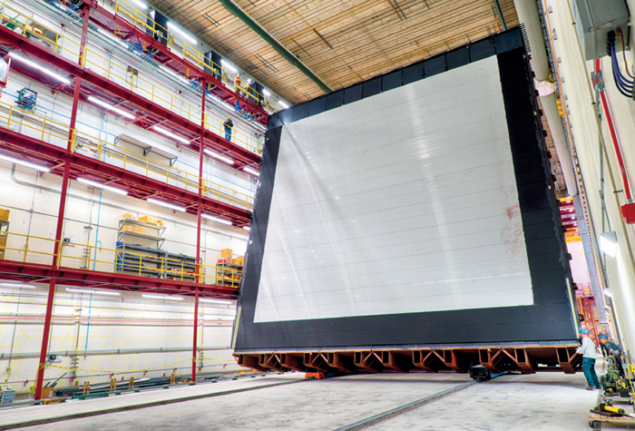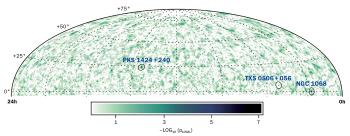
Image credit: Fermilab.
In August, after a 16-month shutdown, Fermilab resumed operation of its Neutrinos at the Main Injector (NuMI) beamline and sent the first muon neutrinos to three neutrino experiments: MINERvA, MINOS+ and the new NOvA experiment. Numerous upgrades to the Fermilab accelerator complex have laid the groundwork for increasing the beam power of the NuMI beamline from about 350 kW to 700 kW. In addition, Fermilab has changed the NuMI horn and target configurations to deliver a higher-energy neutrino beam compared with pre-shutdown operation.
The NOvA experiment – still under construction – will study the properties of neutrinos, especially the elusive transition of muon neutrinos into electron neutrinos. The results will help to answer questions about the neutrino-mass hierarchy, neutrino oscillations and the role that neutrinos might have played in the evolution of the universe. The construction of the NOvA near and far detectors, both located 14 milliradians off the NuMI beam axis, is advancing quickly.
The near detector – located 100 m underground in a new cavern that has been excavated at Fermilab – has more than a quarter of its structure in place. Meanwhile, 810 km away in northern Minnesota, technicians have installed more than three quarters of the plastic structure that is the skeleton of the huge, 14,000 tonne far detector. More than 70% of the far detector’s plastic modules have been filled with 5.7 million litres of liquid scintillator and the first modules are recording data. The first part of the near detector will turn on before the end of the year.
The MINOS+ experiment uses the existing MINOS near and far detectors and takes advantage of the fact that the post-shutdown NuMI neutrino beam differs from earlier operation. The new beam, which is optimized for the NOvA experiment, yields higher-energy neutrinos at the location of the MINOS detector and should not show measurable oscillations. This means that MINOS+ can look for surprises. New types of neutrino interactions could deform the spectrum at the far detector’s distance of 735 km and the observation of additional neutrinos would indicate new physics. The experiment can even search for extra dimensions.
MINERvA – located in front of the MINOS near detector – is a dedicated neutrino-interaction experiment designed to study a range of nuclei. These measurements will not only improve understanding of the nucleus but will also be important inputs to neutrino-oscillation experiments. The MINERvA detector has several targets including helium, carbon, scintillator, water, steel and lead, followed by precise tracking and calorimetry. Previously, MINERvA took data in a beam around 3 GeV, where quasi-elastic, resonance and deep-inelastic scattering processes contribute roughly equally to the event rates. With the new, higher-energy neutrino beam, the event rate is much higher and the events are dominated by deep-inelastic scattering. While MINERvA will study all processes at higher energy, the huge increase in deep-inelastic scattering events in particular will allow precise measurements of the nuclear structure-functions.








